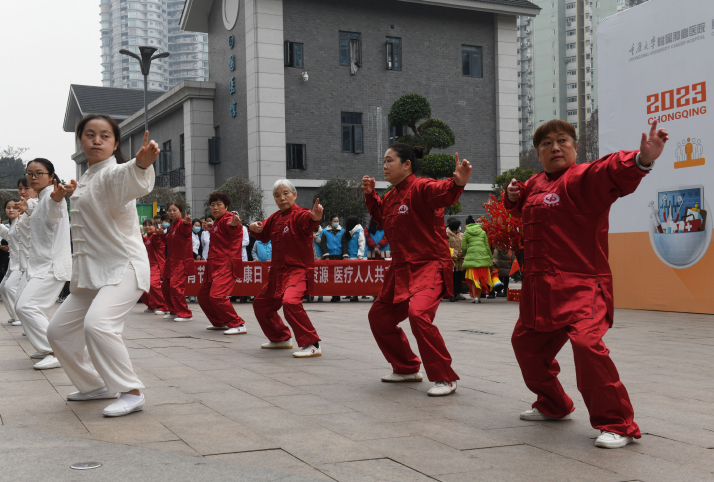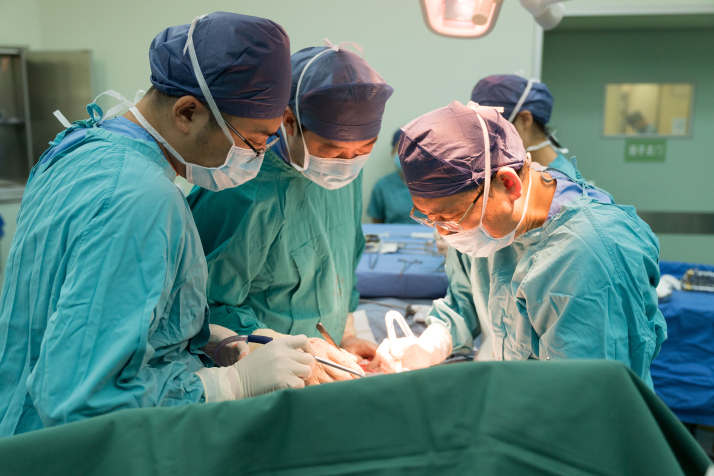| China |
| The status and trend of cancer as well as efforts to fight it in China | |
| The governments' efforts to fight cancer paid off in recent years | |
|
|
 Patients and medical staff get some exercise outside a cancer hospital in Chongqing Municipality on February 3, ahead of World Cancer Day on February 4 (CNSPHOTO)
Three years ago, Wang Yizhuo, a researcher at a Beijing university, was diagnosed with cancer. But "luckily" for him, it was thyroid cancer, which develops in the cells of the gland located at the base of the neck just below the Adam's apple and is sometimes referred to as the "happy cancer." It got its nickname because it appears to be less malignant than other types of cancer. If treated in time, the five-year survival rate for most thyroid cancer patients is over 90 percent. Wang hit rock bottom after receiving the diagnosis, but before long, he picked himself up and received treatment, including surgery, which was successful. But he will be on prescription medication for the rest of his life and still has some other lingering side effects of the disease, such as increased sweating. "I am unlucky and lucky at the same time. The scar on my neck reminds me to live healthier and cherish my life," Wang told Beijing Review. China reports nearly 4.1 million new cancer cases each year, according to the National Cancer Center (NCC) of China, a national organization dedicated to cancer-related issues under the National Health Commission (NHC). In 2019, the center estimated that the annual cancer treatment costs in the country exceeded 220 billion yuan ($30.6 billion), making it one of the major burdens on China's health system. Facing the challenges posed by the leading cause of death worldwide, in mid-November, 13 government agencies, including the NHC, unveiled an eight-year action plan for cancer prevention and treatment, aiming to raise the national cancer survival rate by 2030. According to the plan, by 2030, the capacity for cancer screening, early diagnosis and treatment will be greatly enhanced, the rising trend in cancer incidence and mortality will be curbed, and the burden of disease, such as the medical costs incurred, on patients will be controlled.  A surgical team operates on a cancer patient at a hospital in Beijing in November 2021 (XINHUA)
Status quo and trends Cancer accounted for nearly 10 million deaths in the world in 2020, or nearly one in six deaths, read an article released by the World Health Organization in February 2022. A new study published in The Lancet Public Health journal in December provided a more detailed picture of cancer trends in China. According to the report, the country saw an estimated 21.6-percent increase in cancer deaths between 2005 and 2020, to around 2.39 million. Cancer has been the leading cause of death in China since 2010. Lung, colon, stomach, liver and breast cancers are the most common, according to the NCC. Lung, liver and stomach cancers remain the top three causes of cancer-related deaths, according to the aforementioned study released in The Lancet Public Health, which was led by researchers from the Chinese Center for Disease Control and Prevention and Capital Medical University based in Beijing. The study also highlighted the increasing number of deaths for most cancer types in both rural and urban areas. But notable differences between rural and urban areas, as well as between the sexes, did occur. Age-standardized rates of years of life lost (YLL), a measure of premature mortality calculated by subtracting the age at which a person dies from standard life expectancy, "decreased significantly" for almost all cancers in urban areas, while YLL rates increased for half of the cancer types in rural areas. In urban areas, the study uncovered a rise in YLL rates between 2005 and 2020 caused by pancreatic cancer and mouth cancer among men, and colon cancer among women. In rural areas, lung cancer had become the leading cause of YLL rates for men, displacing liver cancer, and remained the most fatal cancer type for women. Researchers conducting the study said special efforts are needed in light of China's aging population and increasingly modern lifestyles. About one third of cancer deaths are due to tobacco use, high body mass index, alcohol consumption, low fruit and vegetable intake, and physical inactivity, according to the World Health Organization. Zhang Yong, Secretary of the NCC's Communist Party of China Committee, said that about 40 percent of cancer cases can be prevented through reining in risk factors and adopting a healthier lifestyle, such as quitting smoking and reducing alcohol intake, obtaining vaccines against hepatitis B and human papillomavirus and minimizing exposure to carcinogens, especially in the workplace. He also stressed the importance of undergoing authoritative cancer screening and anti-cancer health examinations so as to detect potential malignant tumors at an early stage. Change for the better At the national level, the fight against cancer has been an ongoing effort. Policies have been put forward in response to changing conditions. The eight-year action plan released in November covers the 2023-30 period. It aims to achieve an overall five-year survival rate of 46.6 percent among cancer patients in China by 2030. Currently, the five-year survival rate among cancer patients in the country has increased to 40.5 percent from 30.9 percent a decade ago, with the promotion of tumor registration, cancer screening, and early diagnosis and treatment across the country. The five-year survival rate for breast cancer in China has reached 83 percent, nearing the level in developed countries. The rate for esophageal cancer has also surpassed that in some European and American countries. "The upward trend seen in cancer incidence and death rates in China has been initially curbed, and the incidence of prevalent cancers, such as those in the esophagus, stomach and liver, has been decreasing annually," Guo Yanhong, Director of the NHC's medical emergency response department, said during a news conference on the action plan in November. Moreover, increasing efforts will be made to expand screening, with novel screening and early treatment technologies being developed, as many cancer cases can be cured if detected early and treated effectively. Awareness campaigns will be launched nationwide to keep the public better informed about cancer. In recent years, government programs have begun to offer free cancer screening to residents in some places across the country, including Shanghai, Tianjin, and Zhejiang and Jiangsu provinces. The early diagnosis rate of major cancers in high-prevalence regions had reached 55 percent as of late 2022. "Residents at high risk for cancer, such as those with family history of cancer, long-term smokers or drinkers, people who are exposed to a carcinogen at work for long periods of time, or those who suffer from hepatitis B and precancerous diseases, should all be included in regular cancer screenings," Zhang concluded. Copyedited by Elsbeth van Paridon Comments to luyan@cicgamericas.com |
|
||||||||||||||||||||||||||||
|
